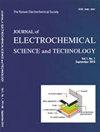商业电化学CO2还原为柴油和甲酸的技术经济研究
IF 3
4区 工程技术
Q3 ELECTROCHEMISTRY
Journal of electrochemical science and technology
Pub Date : 2021-10-18
DOI:10.33961/jecst.2021.00584
引用次数: 3
摘要
利用清洁能源(如太阳能和风能)生产增值燃料和化学品的电化学二氧化碳还原(ECR)是一种很有前途的中和碳循环和再生燃料的技术。目前,ECR已成为生产全球产量不断增长和市场需求旺盛的碳构建模块的最具吸引力的途径。如果以与目前市场价格在财务上具有竞争力的成本生产有价值的产品,则可以广泛实施电化学减少CO 2。本文介绍了采用一致的技术经济方法,将电厂烟气中co2的电化学转化为柴油和甲酸。第一个场景分析了CO(通过CO 2电还原得到)和氢气通过费托法处理形成的柴油的生产,而第二个场景考虑了CO 2直接电化学还原成甲酸。根据从之前的研究中提取的基本情况假设,这两种工艺都无法与现有的燃料价格竞争,这表明电化学(EC)电池的高资本成本是主要的限制因素。在可想象的乐观情况下,柴油燃料生产被预测为具有成本效益的燃料生产的最佳途径,并且甲酸在存储能量含量方面被发现是昂贵的,并且在这些成本下具有易于生产的机制,在经济上与其散装市场价格具有竞争力。在这两种工艺中,影响EC电池资本支出的参数(如电极面积成本、法拉第效率成本和电流密度成本)对液体产品成本影响很大。本文章由计算机程序翻译,如有差异,请以英文原文为准。
A Techno-Economic Study of Commercial Electrochemical CO2 Reduction into Diesel Fuel and Formic Acid
The electrochemical CO 2 reduction (ECR) to produce value-added fuels and chemicals using clean energy sources (like solar and wind) is a promising technology to neutralize the carbon cycle and reproduce the fuels. Presently, the ECR has been the most attractive route to produce carbon-building blocks that have growing global production and high market demand. The electrochemical CO 2 reduction could be extensively implemented if it produces valuable products at those costs which are financially competitive with the present market prices. Herein, the electrochemical conversion of CO 2 obtained from flue gases of a power plant to produce diesel and formic acid using a consistent techno-economic approach is presented. The first scenario analyzed the production of diesel fuel which was formed through Fischer-Tropsch processing of CO (obtained through electroreduction of CO 2 ) and hydrogen, while in the second scenario, direct electrochemical CO 2 reduction to formic acid was considered. As per the base case assumptions extracted from the previous outstanding research studies, both processes weren’t competitive with the existing fuel prices, indicating that high electrochemical (EC) cell capital cost was the main limiting component. The diesel fuel production was predicted as the best route for the cost-effective production of fuels under conceivable optimistic case assumptions, and the formic acid was found to be costly in terms of stored energy contents and has a facile production mechanism at those costs which are financially competitive with its bulk market price. In both processes, the liquid product cost was greatly affected by the parameters affecting the EC cell capital expenses, such as cost concerning the electrode area, faradaic efficiency, and current density.
求助全文
通过发布文献求助,成功后即可免费获取论文全文。
去求助
来源期刊

Journal of electrochemical science and technology
ELECTROCHEMISTRY-
CiteScore
6.30
自引率
8.10%
发文量
44
期刊介绍:
Covering fields:
- Batteries and Energy Storage
- Biological Electrochemistry
- Corrosion Science and Technology
- Electroanalytical Chemistry and Sensor Technology
- Electrocatalysis
- Electrochemical Capacitors & Supercapcitors
- Electrochemical Engineering
- Electrodeposition and Surface Treatment
- Environmental Science and Technology
- Fuel Cells
- Material Electrochemistry
- Molecular Electrochemistry and Organic Electrochemistry
- Physical Electrochemistry
- Solar Energy Conversion and Photoelectrochemistry
 求助内容:
求助内容: 应助结果提醒方式:
应助结果提醒方式:


